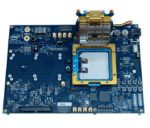Tokyo – Oct. 12, 2023 – NTT Corporation (NTT) said it successfully demonstrated technology that expands transmission capacity while reducing energy use by 67 percent in optical communications platforms; specifically, the C band (near the wavelength of 1550 nm—a major communication wavelength band). To demonstrate this expansion in capacity reduction in power consumption, NTT utilized multi-core […]
NTT Reports Increase in Optical Transmission Capacity, Reduced Power Consumption
Lightelligence Announces Optical Network-on-Chip Processor
Boston –– June 28, 2023 –– Photonic computing company Lightelligence has introduced Hummingbird, an optical network-on-chip (oNOC) processor designed for domain-specific AI workloads. Lightelligence said Hummingbird utilizes vertically stacked packaging technologies to integrate a photonic chip and an electronic chip into a single package serving as the communications network for data centers and other high-performance […]
Never Enough Bandwidth: Optical I/O Consortium Formed to Set Interconnect Standards
More than 20 companies have joined an industry consortium to establish specifications for multi-wavelength integrated optics – the emerging interconnect technology whose advocates say is critical to next-generation HPC and AI. Announced today, the CW-WDM MSA (Continuous-Wave Wavelength Division Multiplexing Multi-Source Agreement) Group, wants to build an ecosystem to work on common standards and interoperability for dense laser light sources, which in turn will enable broad adoption of optical I/O.
Ayar Labs, DARPA and Intel Replace Electronic I/O with Efficient Optical Signaling
Researchers from Intel and Ayar Labs working on PIPES have successfully replaced the traditional electrical input/output (I/O) of a state-of-the-art field programmable gate array (FPGA) with efficient optical signaling interfaces. The demonstration leverages an optical interface developed by Ayar Labs called TeraPHY, an optical I/O chiplet that replaces electrical serializer/deserializer (SERDES) chiplets. “FPGAs with photonic interfaces will have broad impact, improving high-performance computing, artificial intelligence, large-scale emulation, and DoD-specific capabilities such as advanced radars.”
Xilinx Demonstrates Breakthrough Optical Networking on the road to 7 nm
Today Xilinx announced the FPGA industry’s first demonstration of breakthrough 112G PAM4 electrical signaling technology for optical networks, as well as announcing the addition of 58G PAM4 transceivers to its 16nm Virtex UltraScale+ portfolio. “Xilinx has a long history of driving standards efforts and pushing performance limits in serial interconnect technology, and continues to do so with the industry’s first 112G PAM4 demo as well as with its 58G PAM4 solution, here today for customers to begin designing in with,” said Karl Freund, senior analyst, HPC and machine learning, Moor Insights & Strategy. “Today’s Xilinx announcements represent a significant leap forward for network architects who continue to be challenged to improve bandwidth performance of their optical networks.”








